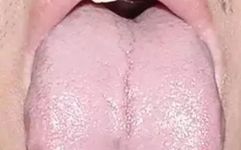Observation of Tongue Quality The tongue quality, or the body of the tongue, is also known as the tongue body, which consists of the tongue’s muscle and vascular tissues. Observing the tongue body mainly involves examining the tongue spirit, tongue color, tongue shape, tongue state, and the sublingual vessels.1. Tongue Spirit(1) With Spirit (Glorious Tongue)【Tongue Manifestation Characteristics】 The tongue color is red, vibrant, and moist, with agile movement.【Clinical Significance】 A glorious tongue indicates a presence of spirit, suggesting a favorable prognosis even in illness.【Mechanism Analysis】 A glorious tongue primarily reflects sufficient body fluids, abundant qi and blood, and a vigorous spirit. The “Guide to Tongue Observation: Differentiating Tongue Spirit and Qi” states: “If the tongue quality is luminous and substantial, regardless of yellow, white, gray, or black, scraping reveals a red and moist interior, and the spirit is glorious, all diseases are auspicious.” (2) Without Spirit (Withered Tongue) 【Tongue Manifestation Characteristics】 The tongue color is dry, dull, lifeless, and lacks vitality, with impaired movement.【Clinical Significance】 A withered tongue indicates a lack of spirit, suggesting a dangerous prognosis.【Mechanism Analysis】 A withered tongue primarily reflects a deficiency of body fluids, severe qi and blood depletion, and a decline in spirit. The “Guide to Tongue Observation: Differentiating Tongue Spirit and Qi” states: “If the tongue quality is devoid of luster and substance, regardless of whether there is coating or not, if the interior appears dry and dull, and the spirit is entirely absent, all diseases are ominous.”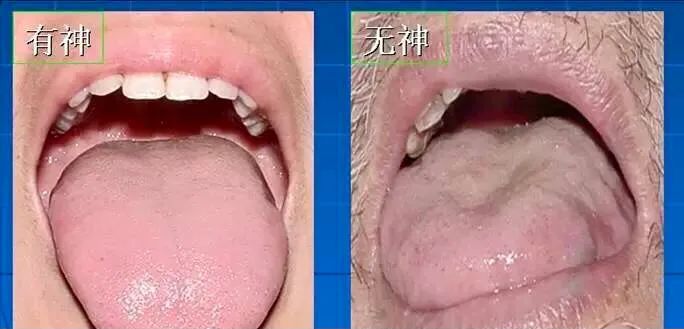 2. Tongue ColorThe tongue color refers to the color of the tongue body.It is generally classified into six types: pale red, pale white, red, crimson, blue, and purple.(1) Pale Red Tongue【Tongue Manifestation Characteristics】 The tongue body is pale red and moist, with a white base showing a hint of red.【Clinical Significance】 A pale red tongue is a sign of harmonious qi and blood, commonly seen in healthy individuals. In disease, it often indicates a mild condition.【Mechanism Analysis】 A pale red tongue primarily reflects a physiological state of sufficient heart qi and blood, and vigorous stomach qi. The formation principle of tongue color is similar to that of skin color; red indicates blood, and bright luster indicates the vitality of stomach qi. As stated in the “Tongue Manifestation Compendium”: “A pale red tongue indicates a normal condition… Red indicates heart qi, and pale indicates stomach qi.” In the early stages of an external pathogen, when the condition is mild and has not yet harmed qi, blood, or internal organs, the tongue color can remain normal and pale red; in cases of internal injury, it suggests a balance of yin and yang, and abundant qi and blood, often indicating a mild condition or a sign of recovery from illness.
2. Tongue ColorThe tongue color refers to the color of the tongue body.It is generally classified into six types: pale red, pale white, red, crimson, blue, and purple.(1) Pale Red Tongue【Tongue Manifestation Characteristics】 The tongue body is pale red and moist, with a white base showing a hint of red.【Clinical Significance】 A pale red tongue is a sign of harmonious qi and blood, commonly seen in healthy individuals. In disease, it often indicates a mild condition.【Mechanism Analysis】 A pale red tongue primarily reflects a physiological state of sufficient heart qi and blood, and vigorous stomach qi. The formation principle of tongue color is similar to that of skin color; red indicates blood, and bright luster indicates the vitality of stomach qi. As stated in the “Tongue Manifestation Compendium”: “A pale red tongue indicates a normal condition… Red indicates heart qi, and pale indicates stomach qi.” In the early stages of an external pathogen, when the condition is mild and has not yet harmed qi, blood, or internal organs, the tongue color can remain normal and pale red; in cases of internal injury, it suggests a balance of yin and yang, and abundant qi and blood, often indicating a mild condition or a sign of recovery from illness. (2) Pale White Tongue【Tongue Manifestation Characteristics】 The tongue color is lighter than normal, with more white than red, referred to as a pale white tongue. If the tongue body is entirely white without any blood color, it is called a withered white tongue.【Clinical Significance】 Indicates deficiency of both qi and blood, and yang deficiency. A withered white tongue indicates damage to essence and depletion of blood and qi.【Mechanism Analysis】 Qi and blood deficiency leads to insufficient nourishment of the tongue, or yang qi deficiency results in weak blood circulation, causing the tongue to appear pale. Yang deficiency leads to internal cold, constricting the meridians, reducing blood flow to the tongue, which can also result in a pale tongue. The “Tongue Diagnosis” indicates that a pale white tongue is the “fundamental color of a cold deficiency tongue.” The WeChat account of meridian studies suggests that if the tongue color is pale and the tongue body is thin, it indicates deficiency of both qi and blood; if it is pale, moist, and the tongue body is plump and tender, it often indicates yang deficiency with water retention. Depletion of essence and blood, loss of blood and qi, and insufficient nourishment of the tongue lead to a withered white tongue. This indicates a serious condition.Pale White Tongue▽
(2) Pale White Tongue【Tongue Manifestation Characteristics】 The tongue color is lighter than normal, with more white than red, referred to as a pale white tongue. If the tongue body is entirely white without any blood color, it is called a withered white tongue.【Clinical Significance】 Indicates deficiency of both qi and blood, and yang deficiency. A withered white tongue indicates damage to essence and depletion of blood and qi.【Mechanism Analysis】 Qi and blood deficiency leads to insufficient nourishment of the tongue, or yang qi deficiency results in weak blood circulation, causing the tongue to appear pale. Yang deficiency leads to internal cold, constricting the meridians, reducing blood flow to the tongue, which can also result in a pale tongue. The “Tongue Diagnosis” indicates that a pale white tongue is the “fundamental color of a cold deficiency tongue.” The WeChat account of meridian studies suggests that if the tongue color is pale and the tongue body is thin, it indicates deficiency of both qi and blood; if it is pale, moist, and the tongue body is plump and tender, it often indicates yang deficiency with water retention. Depletion of essence and blood, loss of blood and qi, and insufficient nourishment of the tongue lead to a withered white tongue. This indicates a serious condition.Pale White Tongue▽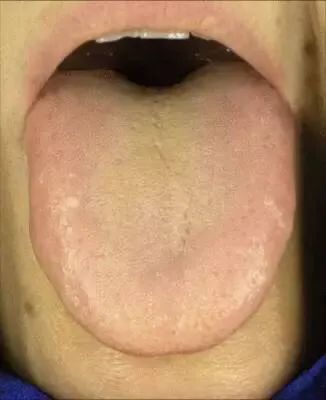 Withered White Tongue▽
Withered White Tongue▽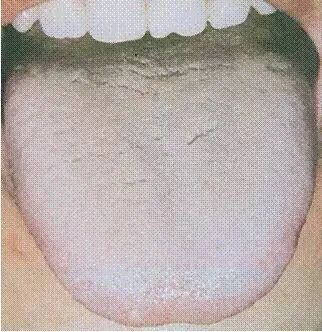 (3) Red Tongue【Tongue Manifestation Characteristics】 The tongue color is redder than normal, and if it is bright red, it is called a red tongue.【Clinical Significance】 Indicates excess heat, and internal heat due to yin deficiency.【Mechanism Analysis】 Blood becomes active with heat, causing blood vessels to dilate and blood flow to accelerate, leading to a bright red tongue; or due to yin deficiency and dehydration, causing internal fire to rise in the tongue. A slightly red tongue or only the tip and edges being red often indicates the initial stage of an external heat condition. A red and cracked tongue tip often indicates heart fire. Red edges of the tongue often indicate excess heat in the liver meridian. A red tongue with coating often indicates excess heat; a bright red tongue with little coating or cracks, and a thin tongue often indicates deficiency heat. The “Guide to Tongue Observation” states: “A bright red tongue with no coating, no moisture at the tongue base, and no liquid on the tongue surface indicates yin deficiency and fire.”Red Tongue▽
(3) Red Tongue【Tongue Manifestation Characteristics】 The tongue color is redder than normal, and if it is bright red, it is called a red tongue.【Clinical Significance】 Indicates excess heat, and internal heat due to yin deficiency.【Mechanism Analysis】 Blood becomes active with heat, causing blood vessels to dilate and blood flow to accelerate, leading to a bright red tongue; or due to yin deficiency and dehydration, causing internal fire to rise in the tongue. A slightly red tongue or only the tip and edges being red often indicates the initial stage of an external heat condition. A red and cracked tongue tip often indicates heart fire. Red edges of the tongue often indicate excess heat in the liver meridian. A red tongue with coating often indicates excess heat; a bright red tongue with little coating or cracks, and a thin tongue often indicates deficiency heat. The “Guide to Tongue Observation” states: “A bright red tongue with no coating, no moisture at the tongue base, and no liquid on the tongue surface indicates yin deficiency and fire.”Red Tongue▽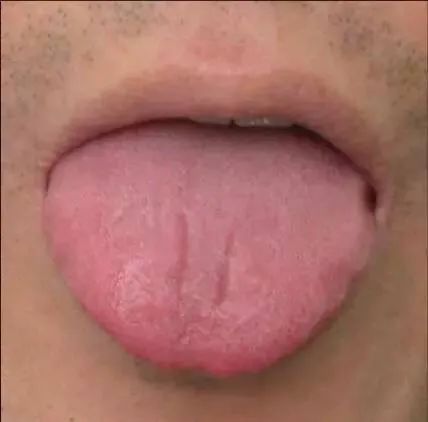 Red Tip and Edges▽
Red Tip and Edges▽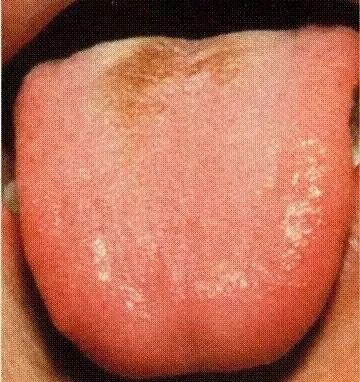 Bright Red Tongue with Little Coating▽
Bright Red Tongue with Little Coating▽ (4) Crimson Tongue【Tongue Manifestation Characteristics】 A tongue that is deeper red or slightly dark red is called a crimson tongue.【Clinical Significance】 Indicates excessive internal heat and vigorous fire due to yin deficiency.【Mechanism Analysis】 A crimson tongue often develops from a red tongue. The causes include excessive evil heat, surging qi and blood, leading to a red and swollen tongue; or heat entering the nutrient blood, damaging the yin of the blood, causing blood to become concentrated and heat to fill the tongue; or due to yin deficiency and dehydration, causing internal fire to rise in the tongue. Therefore, a crimson tongue indicates a more severe condition than a red tongue. A crimson tongue with coating often indicates an external heat condition or internal mixed diseases with excessive yang heat; the “Guide to Tongue Observation” states: “Crimson is a deep red color. The heart governs the nutrient and blood, and if the tongue coating is crimson and dry, the evil has entered the nutrient level.” A crimson tongue with little or no coating indicates damage to the stomach and kidney yin, often due to the late stage of a heat disease or prolonged illness with vigorous fire due to yin deficiency, indicating deficiency heat. The “Guide to Tongue Observation” states: “A crimson and shiny tongue indicates loss of stomach yin.” “If the tongue is crimson but not bright, dry and withered, it indicates depletion of kidney yin.”Crimson Tongue▽
(4) Crimson Tongue【Tongue Manifestation Characteristics】 A tongue that is deeper red or slightly dark red is called a crimson tongue.【Clinical Significance】 Indicates excessive internal heat and vigorous fire due to yin deficiency.【Mechanism Analysis】 A crimson tongue often develops from a red tongue. The causes include excessive evil heat, surging qi and blood, leading to a red and swollen tongue; or heat entering the nutrient blood, damaging the yin of the blood, causing blood to become concentrated and heat to fill the tongue; or due to yin deficiency and dehydration, causing internal fire to rise in the tongue. Therefore, a crimson tongue indicates a more severe condition than a red tongue. A crimson tongue with coating often indicates an external heat condition or internal mixed diseases with excessive yang heat; the “Guide to Tongue Observation” states: “Crimson is a deep red color. The heart governs the nutrient and blood, and if the tongue coating is crimson and dry, the evil has entered the nutrient level.” A crimson tongue with little or no coating indicates damage to the stomach and kidney yin, often due to the late stage of a heat disease or prolonged illness with vigorous fire due to yin deficiency, indicating deficiency heat. The “Guide to Tongue Observation” states: “A crimson and shiny tongue indicates loss of stomach yin.” “If the tongue is crimson but not bright, dry and withered, it indicates depletion of kidney yin.”Crimson Tongue▽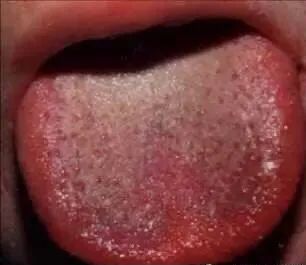
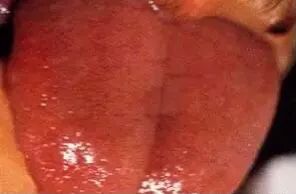
 (5) Blue-Purple Tongue【Tongue Manifestation Characteristics】 The entire tongue appears uniformly blue or purple, or there are local blue-purple spots, collectively referred to as blue-purple tongue. Blue-purple tongue can also present in various forms, such as a pale blue-purple tongue; a red or crimson tongue with blue-purple hues; or local blue-purple spots on the tongue, varying in size and not elevated above the tongue surface, referred to as “stagnation spots tongue” or “stagnation point tongue.”【Clinical Significance】 Indicates poor circulation of qi and blood.【Mechanism Analysis】 A blue-purple tongue is caused by poor circulation of qi and blood. A uniformly blue-purple tongue indicates significant blood stasis, often due to systemic blood stasis; a tongue with purple spots indicates a lighter degree of stasis, often seen in local stasis or local vascular damage. The WeChat account of meridian studies suggests that the depth of the blue-purple tongue color is related to the nature of cold and heat. A pale blue-purple or dark purple and moist tongue is often seen in conditions of yang deficiency and yin excess. This is often due to internal cold, with yang qi not being expressed, leading to poor circulation of qi and blood, and blood stasis. A blue tongue indicates severe cold and blood stasis, suggesting internal cold and obstruction of yang qi, leading to stagnant blood flow. A dark purple or crimson tongue that is dry and lacks moisture, with little or no coating, is often seen in heat conditions, indicating excessive heat toxins penetrating the nutrient blood, damaging the yin, and causing poor circulation of qi and blood. A blue-purple tongue can also be seen in certain congenital heart diseases or in cases of drug or food poisoning. Additionally, traumatic injuries can damage blood vessels, causing blood to leak and resulting in spots on the tongue, which may not show obvious abnormalities. A dark purple tongue or a tongue with spots is often due to internal blood stasis.Pale Blue-Purple Tongue▽
(5) Blue-Purple Tongue【Tongue Manifestation Characteristics】 The entire tongue appears uniformly blue or purple, or there are local blue-purple spots, collectively referred to as blue-purple tongue. Blue-purple tongue can also present in various forms, such as a pale blue-purple tongue; a red or crimson tongue with blue-purple hues; or local blue-purple spots on the tongue, varying in size and not elevated above the tongue surface, referred to as “stagnation spots tongue” or “stagnation point tongue.”【Clinical Significance】 Indicates poor circulation of qi and blood.【Mechanism Analysis】 A blue-purple tongue is caused by poor circulation of qi and blood. A uniformly blue-purple tongue indicates significant blood stasis, often due to systemic blood stasis; a tongue with purple spots indicates a lighter degree of stasis, often seen in local stasis or local vascular damage. The WeChat account of meridian studies suggests that the depth of the blue-purple tongue color is related to the nature of cold and heat. A pale blue-purple or dark purple and moist tongue is often seen in conditions of yang deficiency and yin excess. This is often due to internal cold, with yang qi not being expressed, leading to poor circulation of qi and blood, and blood stasis. A blue tongue indicates severe cold and blood stasis, suggesting internal cold and obstruction of yang qi, leading to stagnant blood flow. A dark purple or crimson tongue that is dry and lacks moisture, with little or no coating, is often seen in heat conditions, indicating excessive heat toxins penetrating the nutrient blood, damaging the yin, and causing poor circulation of qi and blood. A blue-purple tongue can also be seen in certain congenital heart diseases or in cases of drug or food poisoning. Additionally, traumatic injuries can damage blood vessels, causing blood to leak and resulting in spots on the tongue, which may not show obvious abnormalities. A dark purple tongue or a tongue with spots is often due to internal blood stasis.Pale Blue-Purple Tongue▽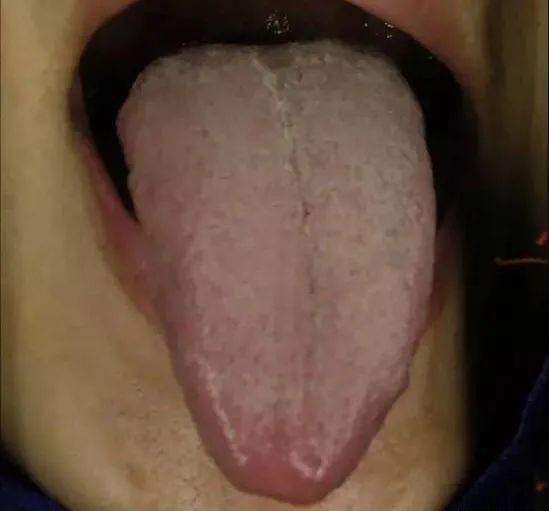 Blue-Purple Tongue▽
Blue-Purple Tongue▽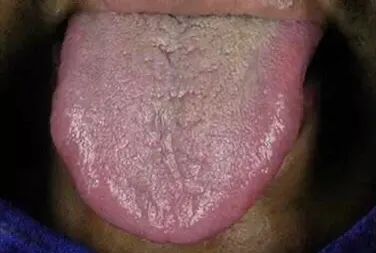 Purple-Crimson Tongue▽
Purple-Crimson Tongue▽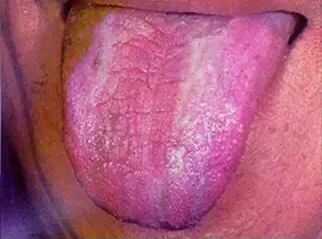 Stagnation Point Tongue▽
Stagnation Point Tongue▽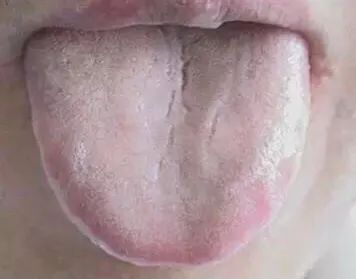 Stagnation Spot Tongue▽
Stagnation Spot Tongue▽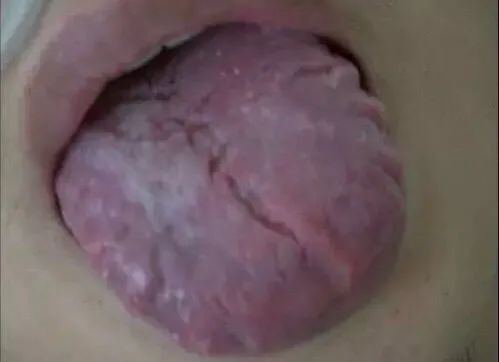 3. Tongue ShapeThe shape and quality of the tongue include aspects such as age, thickness, points, cracks, and teeth marks.(1) Old and Young【Tongue Manifestation Characteristics】 A tongue with rough or shriveled texture, a firm and aged appearance, and a darker color is called an old tongue; a tongue with fine texture, a plump and tender appearance, and a lighter color is called a young tongue.【Clinical Significance】 An old tongue is often seen in excess conditions; a young tongue is often seen in deficiency conditions.【Mechanism Analysis】 The quality of the tongue reflects a comprehensive manifestation of age. Old and young are indicators of the deficiency or excess of disease. The “Guide to Tongue Observation” states: “If the tongue quality is firm and aged, regardless of whether the coating is white, yellow, gray, or black, the disease is often excess; if the tongue quality is plump and tender, regardless of whether the coating is gray, black, yellow, or white, the disease is often deficiency.” When evil qi is excessive and fills the body, the righteous qi is not weakened, and the evil qi stagnates in the tongue, leading to an aged tongue. Insufficient qi and blood fail to nourish the tongue; or if yang qi is deficient, blood circulation is weak, resulting in a young tongue with a pale color. Insufficient essence and blood lead to a young tongue that is red with little coating.Old Tongue▽
3. Tongue ShapeThe shape and quality of the tongue include aspects such as age, thickness, points, cracks, and teeth marks.(1) Old and Young【Tongue Manifestation Characteristics】 A tongue with rough or shriveled texture, a firm and aged appearance, and a darker color is called an old tongue; a tongue with fine texture, a plump and tender appearance, and a lighter color is called a young tongue.【Clinical Significance】 An old tongue is often seen in excess conditions; a young tongue is often seen in deficiency conditions.【Mechanism Analysis】 The quality of the tongue reflects a comprehensive manifestation of age. Old and young are indicators of the deficiency or excess of disease. The “Guide to Tongue Observation” states: “If the tongue quality is firm and aged, regardless of whether the coating is white, yellow, gray, or black, the disease is often excess; if the tongue quality is plump and tender, regardless of whether the coating is gray, black, yellow, or white, the disease is often deficiency.” When evil qi is excessive and fills the body, the righteous qi is not weakened, and the evil qi stagnates in the tongue, leading to an aged tongue. Insufficient qi and blood fail to nourish the tongue; or if yang qi is deficient, blood circulation is weak, resulting in a young tongue with a pale color. Insufficient essence and blood lead to a young tongue that is red with little coating.Old Tongue▽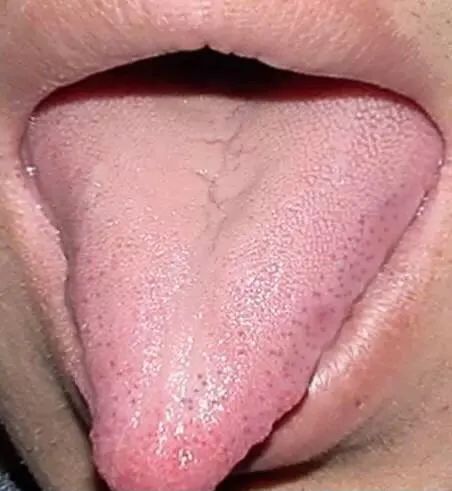 Young Tongue▽
Young Tongue▽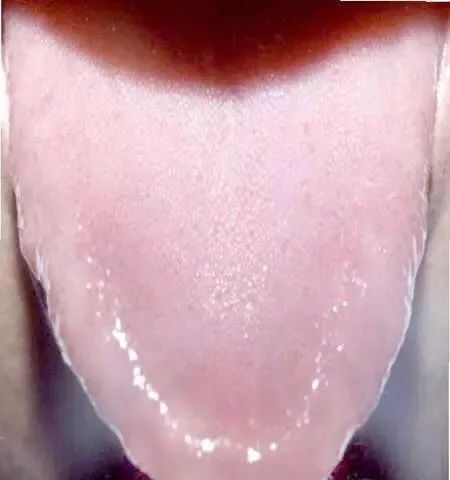 (2) Thick and Thin【Tongue Manifestation Characteristics】 A tongue that is larger and thicker than normal, filling the mouth, is called a thick tongue. A tongue that is thin and smaller than normal is called a thin tongue.【Clinical Significance】 A thick tongue often indicates internal retention of dampness; a swollen tongue indicates excessive heat in the heart and spleen, or external damp-heat. A thin tongue indicates insufficient qi and blood, and vigorous fire due to yin deficiency.【Mechanism Analysis】 A thick tongue is often due to spleen and kidney yang deficiency, leading to abnormal qi transformation, obstruction of fluid distribution, and internal retention of dampness. A pale white tongue with a thick tongue often indicates qi deficiency and yang deficiency. A swollen tongue that is red often indicates internal heat. A swollen tongue that is crimson is often seen in cases of excessive heat in the heart and spleen, or damp-heat accumulation. Additionally, congenital tongue hemangioma patients may present with local swelling of the tongue that is purple, indicating local lesions due to blood stasis, often without systemic diagnostic significance. A thin tongue is often due to insufficient qi, blood, and body fluids, leading to inadequate nourishment of the tongue. A thin tongue with a pale color is often seen in prolonged illness with deficiency of both qi and blood, where blood fails to nourish the tongue; a thin tongue with a crimson color, dry with little or no coating, is often seen in cases of vigorous fire due to yin deficiency, where yin fluids cannot nourish the tongue, leading to a thin tongue, and vigorous fire causes the tongue to appear crimson, with dryness and little or no coating.Thick Tongue▽
(2) Thick and Thin【Tongue Manifestation Characteristics】 A tongue that is larger and thicker than normal, filling the mouth, is called a thick tongue. A tongue that is thin and smaller than normal is called a thin tongue.【Clinical Significance】 A thick tongue often indicates internal retention of dampness; a swollen tongue indicates excessive heat in the heart and spleen, or external damp-heat. A thin tongue indicates insufficient qi and blood, and vigorous fire due to yin deficiency.【Mechanism Analysis】 A thick tongue is often due to spleen and kidney yang deficiency, leading to abnormal qi transformation, obstruction of fluid distribution, and internal retention of dampness. A pale white tongue with a thick tongue often indicates qi deficiency and yang deficiency. A swollen tongue that is red often indicates internal heat. A swollen tongue that is crimson is often seen in cases of excessive heat in the heart and spleen, or damp-heat accumulation. Additionally, congenital tongue hemangioma patients may present with local swelling of the tongue that is purple, indicating local lesions due to blood stasis, often without systemic diagnostic significance. A thin tongue is often due to insufficient qi, blood, and body fluids, leading to inadequate nourishment of the tongue. A thin tongue with a pale color is often seen in prolonged illness with deficiency of both qi and blood, where blood fails to nourish the tongue; a thin tongue with a crimson color, dry with little or no coating, is often seen in cases of vigorous fire due to yin deficiency, where yin fluids cannot nourish the tongue, leading to a thin tongue, and vigorous fire causes the tongue to appear crimson, with dryness and little or no coating.Thick Tongue▽
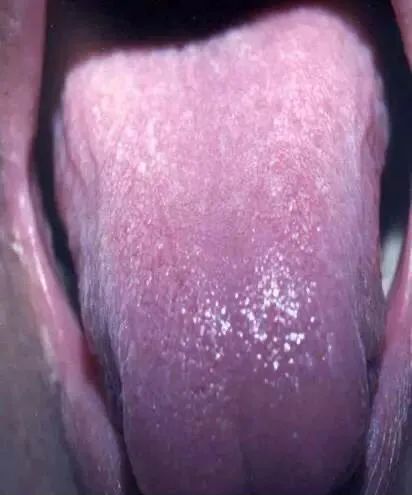
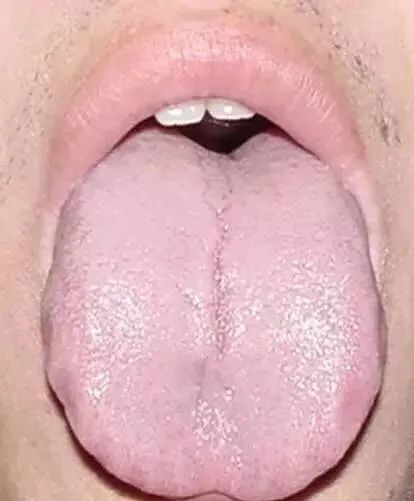 Thin Tongue▽
Thin Tongue▽
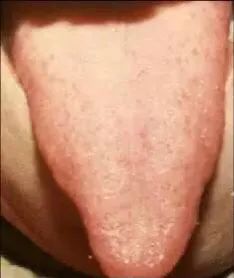
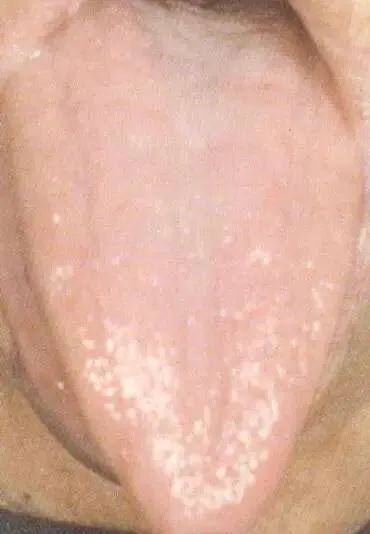 (3) Points and Spikes【Tongue Manifestation Characteristics】 Points refer to red or purple-red star-like protrusions on the tongue surface. Larger ones are called stars, and smaller ones are called points. Red ones are called red star tongue or red point tongue; white ones are called white star tongue. Spikes refer to enlarged and elevated fungiform papillae forming sharp peaks, resembling thorns, called thorn tongue. Points and spikes are similar and can appear together, hence collectively referred to as point-spike tongue. Point-spike tongue is most commonly seen at the tip of the tongue.【Clinical Significance】 Indicates excessive yang heat in the organs, or heat in the blood.Based on the location of the points and spikes, one can generally infer where the heat is located. For example, if points and spikes appear at the tip of the tongue, it often indicates excessive heart fire; if they appear in the middle of the tongue, it often indicates excessive heat in the stomach and intestines; if they appear on both sides of the tongue, it often indicates heat in the liver and gallbladder, etc.【Mechanism Analysis】 Points and spikes are pathological features of swollen or elevated fungiform papillae. Points are enlarged and increased in number, with the papillae filled with blood and edema, even forming sharp peaks resembling thorns, often due to internal evil heat accumulating and filling the tongue vessels. The number of points and spikes correlates with the degree of evil heat; the more points and spikes, the more severe the evil heat. Observing the color of the points and spikes can estimate the circulation of qi and blood and the severity of the disease. For example, bright red points indicate excessive blood heat or vigorous fire due to yin deficiency; dark purple points indicate heat accumulation and qi and blood stagnation.
(3) Points and Spikes【Tongue Manifestation Characteristics】 Points refer to red or purple-red star-like protrusions on the tongue surface. Larger ones are called stars, and smaller ones are called points. Red ones are called red star tongue or red point tongue; white ones are called white star tongue. Spikes refer to enlarged and elevated fungiform papillae forming sharp peaks, resembling thorns, called thorn tongue. Points and spikes are similar and can appear together, hence collectively referred to as point-spike tongue. Point-spike tongue is most commonly seen at the tip of the tongue.【Clinical Significance】 Indicates excessive yang heat in the organs, or heat in the blood.Based on the location of the points and spikes, one can generally infer where the heat is located. For example, if points and spikes appear at the tip of the tongue, it often indicates excessive heart fire; if they appear in the middle of the tongue, it often indicates excessive heat in the stomach and intestines; if they appear on both sides of the tongue, it often indicates heat in the liver and gallbladder, etc.【Mechanism Analysis】 Points and spikes are pathological features of swollen or elevated fungiform papillae. Points are enlarged and increased in number, with the papillae filled with blood and edema, even forming sharp peaks resembling thorns, often due to internal evil heat accumulating and filling the tongue vessels. The number of points and spikes correlates with the degree of evil heat; the more points and spikes, the more severe the evil heat. Observing the color of the points and spikes can estimate the circulation of qi and blood and the severity of the disease. For example, bright red points indicate excessive blood heat or vigorous fire due to yin deficiency; dark purple points indicate heat accumulation and qi and blood stagnation.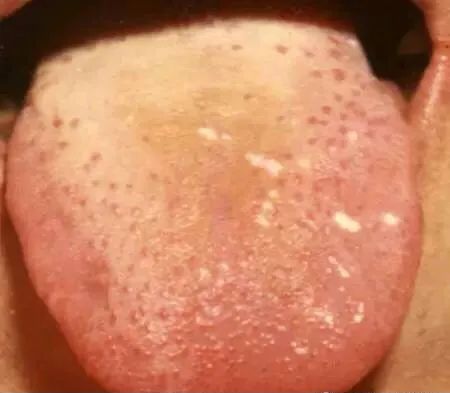
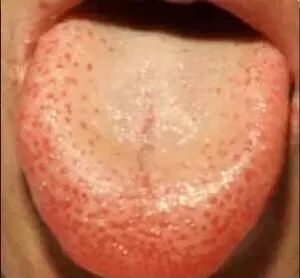
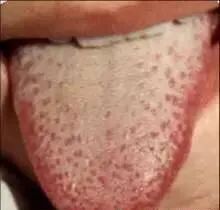 (4) Cracks【Tongue Manifestation Characteristics】 Various shapes of cracks and fissures appear on the tongue surface, varying in depth and number, collectively referred to as cracked tongue. Cracks or fissures without tongue coating are often pathological changes; cracks can take shapes resembling “人”, “|”, “井”, etc., and in severe cases can appear convoluted, pebble-like, or as if cut or crushed. If there is tongue coating in the cracks, it is often congenital cracks.【Clinical Significance】 Often seen in cases of essence and blood deficiency, or vigorous fire due to yin deficiency, or spleen qi deficiency.【Mechanism Analysis】 Cracked tongue is often caused by insufficient nourishment of the tongue, atrophy of the tongue papillae, or tissue fissuring. It is a manifestation of systemic malnutrition. A pale white tongue with cracks indicates blood deficiency, often due to blood deficiency failing to nourish the tongue, hence the “Guide to Tongue Observation” states: “Those with cracks indicate blood deficiency.” Few and shallow cracks indicate mild deficiency; many and deep cracks indicate severe deficiency. A red or crimson tongue with cracks indicates damage to body fluids due to excessive heat, or vigorous fire due to yin deficiency, leading to loss of nourishment for the tongue. A uniformly crimson tongue, or one with horizontal or vertical cracks that are short, indicates yin deficiency and fluid depletion. A pale white, plump tongue with teeth marks and cracks indicates spleen qi deficiency and insufficient nourishment of the tongue. In healthy individuals, about 0.5% have deep longitudinal or transverse grooves on the tongue surface, with coating in the cracks, and no discomfort, indicating congenital tongue fissures, distinct from pathological cracked tongue.
(4) Cracks【Tongue Manifestation Characteristics】 Various shapes of cracks and fissures appear on the tongue surface, varying in depth and number, collectively referred to as cracked tongue. Cracks or fissures without tongue coating are often pathological changes; cracks can take shapes resembling “人”, “|”, “井”, etc., and in severe cases can appear convoluted, pebble-like, or as if cut or crushed. If there is tongue coating in the cracks, it is often congenital cracks.【Clinical Significance】 Often seen in cases of essence and blood deficiency, or vigorous fire due to yin deficiency, or spleen qi deficiency.【Mechanism Analysis】 Cracked tongue is often caused by insufficient nourishment of the tongue, atrophy of the tongue papillae, or tissue fissuring. It is a manifestation of systemic malnutrition. A pale white tongue with cracks indicates blood deficiency, often due to blood deficiency failing to nourish the tongue, hence the “Guide to Tongue Observation” states: “Those with cracks indicate blood deficiency.” Few and shallow cracks indicate mild deficiency; many and deep cracks indicate severe deficiency. A red or crimson tongue with cracks indicates damage to body fluids due to excessive heat, or vigorous fire due to yin deficiency, leading to loss of nourishment for the tongue. A uniformly crimson tongue, or one with horizontal or vertical cracks that are short, indicates yin deficiency and fluid depletion. A pale white, plump tongue with teeth marks and cracks indicates spleen qi deficiency and insufficient nourishment of the tongue. In healthy individuals, about 0.5% have deep longitudinal or transverse grooves on the tongue surface, with coating in the cracks, and no discomfort, indicating congenital tongue fissures, distinct from pathological cracked tongue.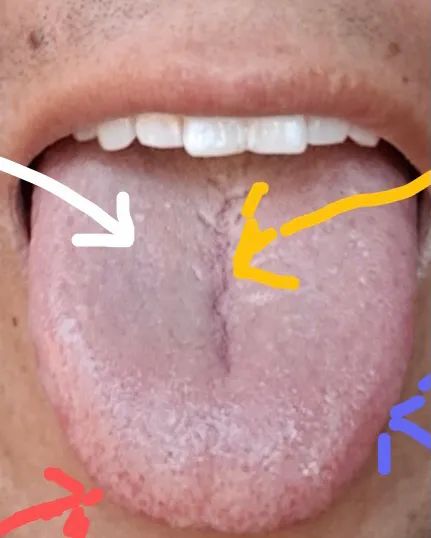
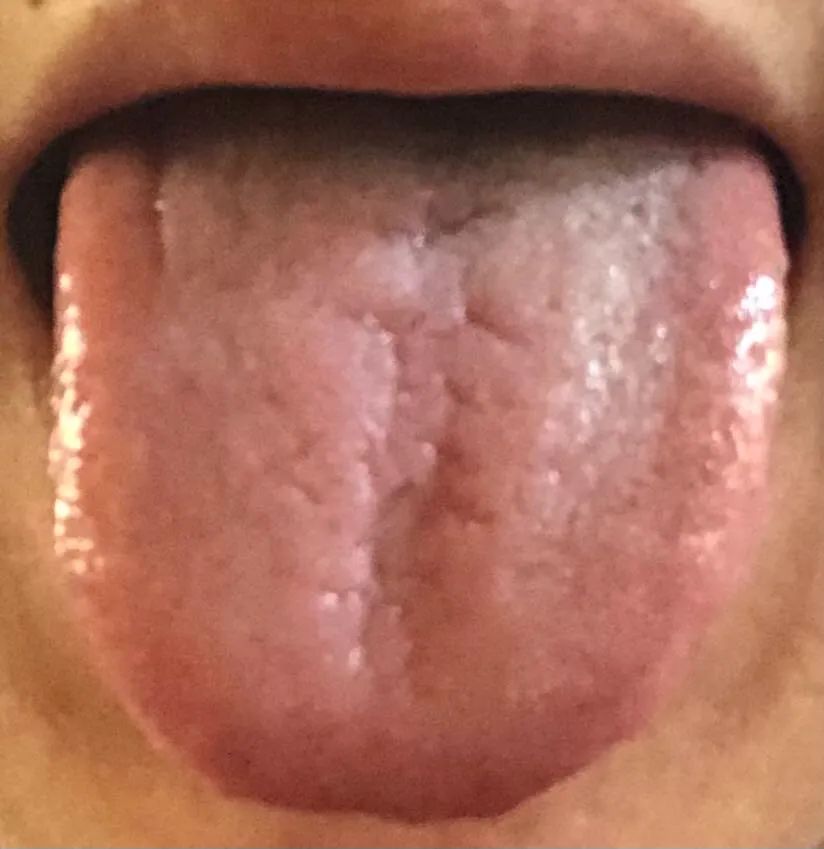 (5) Teeth Marked Tongue【Tongue Manifestation Characteristics】 The edges of the tongue show marks from teeth pressure, often accompanied by a plump tongue body.【Clinical Significance】 Indicates spleen deficiency and internal retention of dampness.【Mechanism Analysis】 Teeth marks on the tongue edges are often due to pressure from a plump tongue body. Therefore, it is often seen with a thick tongue. A tongue that is not plump but has teeth marks is referred to as a delicate teeth marked tongue. A pale, plump tongue that is moist, with teeth marks, often indicates internal retention of cold dampness, or yang deficiency with internal water retention; a pale red tongue with teeth marks is commonly seen in spleen deficiency and qi deficiency; if the tongue is red, swollen, and fills the mouth, with teeth marks, it indicates internal damp-heat phlegm accumulation. Additionally, those with congenital teeth marked tongues often have a tongue that is not large, pale red, and tender, with slight teeth marks; in pathological cases, this indicates a milder condition, often seen in children and those with insufficient qi and blood.
(5) Teeth Marked Tongue【Tongue Manifestation Characteristics】 The edges of the tongue show marks from teeth pressure, often accompanied by a plump tongue body.【Clinical Significance】 Indicates spleen deficiency and internal retention of dampness.【Mechanism Analysis】 Teeth marks on the tongue edges are often due to pressure from a plump tongue body. Therefore, it is often seen with a thick tongue. A tongue that is not plump but has teeth marks is referred to as a delicate teeth marked tongue. A pale, plump tongue that is moist, with teeth marks, often indicates internal retention of cold dampness, or yang deficiency with internal water retention; a pale red tongue with teeth marks is commonly seen in spleen deficiency and qi deficiency; if the tongue is red, swollen, and fills the mouth, with teeth marks, it indicates internal damp-heat phlegm accumulation. Additionally, those with congenital teeth marked tongues often have a tongue that is not large, pale red, and tender, with slight teeth marks; in pathological cases, this indicates a milder condition, often seen in children and those with insufficient qi and blood.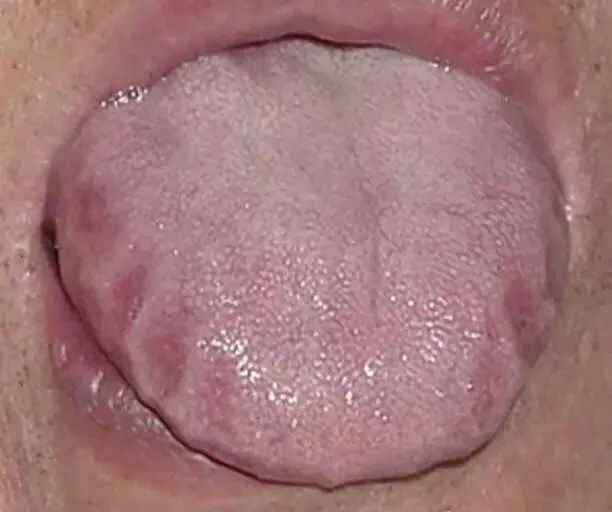
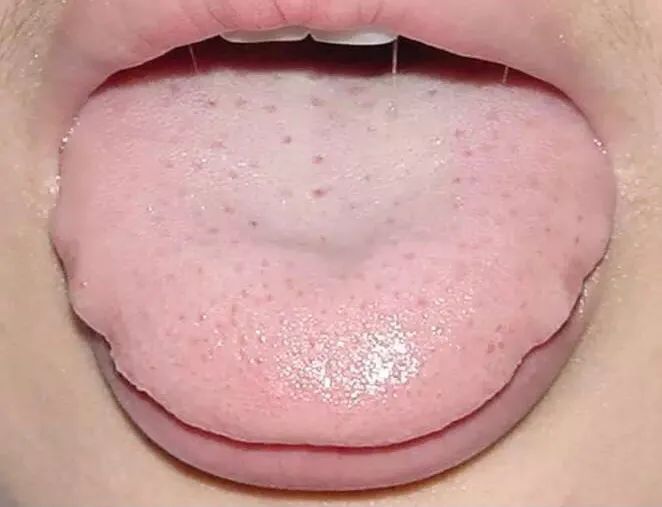

Popular Reads(Click the title to view)
1. Four Key Acupoints for Dealing with Constipation, Useful in Critical Moments
2. The Armpit is the “Gate of Life” for Heart Disease Patients! Regularly Patting It Shows Heart Strengthening Effects~
3. The Calf is Connected to the Liver, Brain, and Heart, but Many People Overlook It, Leading to Various Illnesses! Be Sure to Check It Out
4. There is a “Water Faucet” in the Body; Just Turn It On, and All Body Aches Will Gradually Wash Away
5. Effective Weight Loss, Just Four Acupoints; Use Them Well, and You Won’t Gain Weight Even in Old Age!
6. If You Feel Pain Everywhere, Learn This One Move, and You Won’t Hurt Anymore!
【Meridian Studies】Exciting RecommendationsClick to Explore
| Human Meridian Inquiry | Human Acupoint Inquiry | Common Disease Inquiry |
| Massage Technique Explanation | Technique Video Explanation | Pediatric Disease Inquiry |
| Hand Diagnosis | Facial Diagnosis | Nine Major Constitutions |
| Tongue Diagnosis | Back Diagnosis | Foot Reflex Zones |
If you find this useful, please click the button belowto view more

